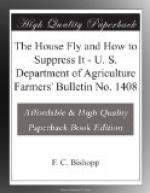WHERE THE TRUE HOUSE FLY LAYS ITS EGGS.
The true house fly (fig. 3), which is found in nearly all parts of the world, is a medium-sized fly with four black stripes on the back and a sharp elbow in one of the veins of the wings. The house fly can not bite, its mouth parts being spread out at the tip for sucking up liquid substances.
The eggs (figs. 4, 5) are laid upon horse manure. This substance seems to be its favorite larval food. It will breed also in human excrement, and because of this habit it is very dangerous to the health of human beings, carrying as it does the germs of intestinal diseases, such as typhoid fever and cholera, from the excreta to food supplies. It has also been found to breed freely in hog manure, in considerable numbers in chicken dung, and to some extent in cow manure. Indeed, it will lay its eggs on a great variety of decaying vegetable and animal materials, but of the flies that infest dwelling houses, both in cities and on farms, a vast proportion come from horse manure.
[Illustration: FIG. 4.—Eggs of the house fly. About natural size. (Newstead.)]
It often happens, however, that this fly is very abundant in localities where little or no horse manure is found, and in such cases it breeds in other manure, such as chicken manure in backyard poultry lots, or in slops or fermenting vegetable material, such as spent hops, moist bran, ensilage, or rotting potatoes. Accumulations of organic material on the dumping grounds of towns and cities often produce flies in great numbers.
[Illustration: FIG. 5.—Eggs of the house fly. Highly magnified. (Newstead.)]
The house fly begins laying eggs in from 2 1/2 to 20 days after emerging, the time interval depending to a large extent upon temperature, humidity, and character and abundance of food. The number of eggs laid by an individual fly at one time ranges from 120 to 159 and a single female will usually lay two and sometimes four such batches. Dunn has recently reported that in Panama a fly may deposit as many as 2,367 eggs in 21 batches, and sometimes an interval of only 36 hours may occur between the deposition of large batches of eggs. The enormous numbers in which the insects occur are thus plainly accounted for, especially when the abundance and universal occurrence of appropriate larval food is considered. The eggs are deposited below the surface in the cracks and interstices of the manure, several females usually depositing in one spot, so that the eggs commonly are found in large clusters (fig. 4) in selected places near the top of the pile, where a high degree of heat is maintained by the fermentation below. The second batch of eggs is laid from 8 to 10 days after the first. The eggs usually hatch in less than 24 hours. Under the most favorable conditions of temperature and moisture the egg state may last hardly more than 8 hours. The maggots which issue from the eggs




